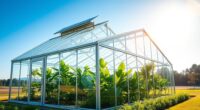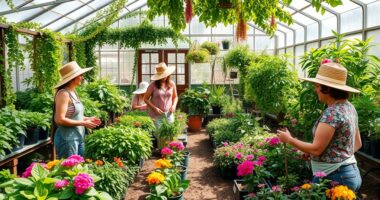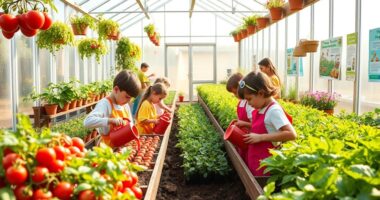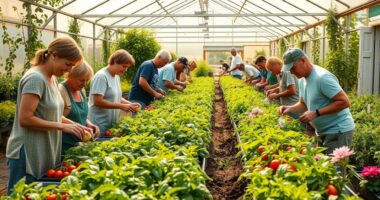In this interview, Emily Carter shares her journey designing a sustainable, low-cost DIY greenhouse. She highlights how she repurposed reclaimed materials like salvaged windows, scrap wood, and plastic containers to build an eco-friendly space. Emily emphasizes using passive solar techniques, composting, rainwater harvesting, and vertical gardening to maximize efficiency. Her approach proves that creating an environmentally conscious greenhouse doesn’t need to be expensive. Keep exploring her innovative strategies to inspire your own sustainable gardening projects.
Key Takeaways
- Emily Carter shares her journey of designing a sustainable, budget-friendly greenhouse using recycled and locally sourced materials.
- She emphasizes passive solar heating and thermal mass techniques to maximize energy efficiency naturally.
- Emily discusses her resourceful approach to space optimization, including vertical gardening and repurposed shelving.
- She highlights eco-friendly gardening practices like composting, organic fertilizers, and rainwater harvesting to enhance sustainability.
- Emily offers tips for beginners to start small, think creatively, and prioritize eco-conscious choices in greenhouse building.
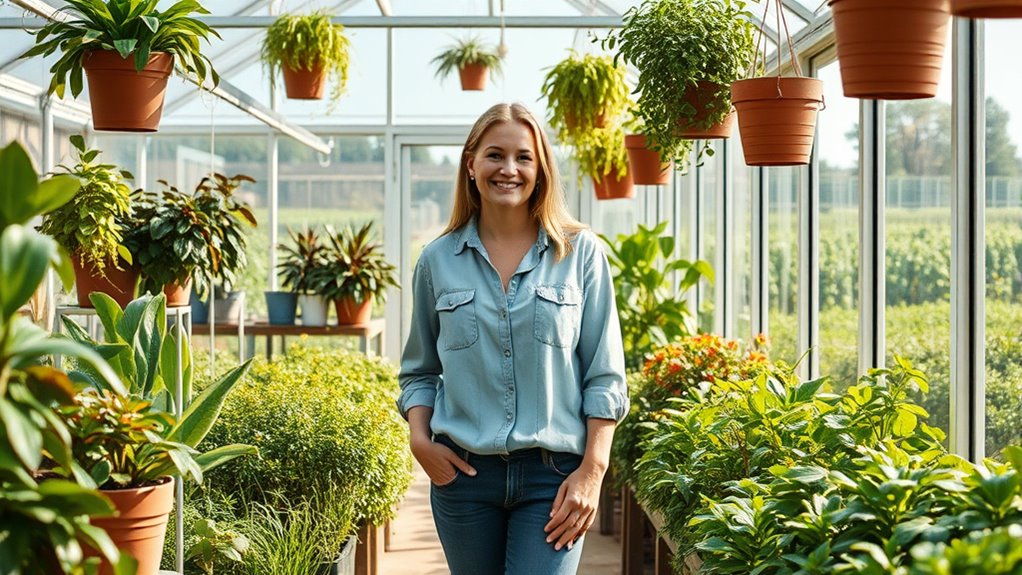
Have you ever wondered how to build a sustainable greenhouse on a budget? Emily Carter’s journey into DIY greenhouse creation offers invaluable insights that can help you do just that. When it comes to sustainable design, Emily emphasizes that you don’t need to spend a fortune to create an eco-friendly space. Instead, focus on using locally sourced, recycled, or repurposed materials. For example, she suggests salvaging old windows, scrap wood, or plastic containers, which not only cuts costs but also reduces waste. This approach allows you to craft a greenhouse that’s both environmentally responsible and budget-friendly. Emily’s philosophy revolves around minimal environmental impact, and she encourages others to embrace the same mindset by selecting sustainable design elements that work within their means.
Build a sustainable, budget-friendly greenhouse using recycled materials and eco-conscious design principles.
To start, she recommends planning your greenhouse with efficiency in mind. Think about how sunlight will hit your space throughout the day and optimize your design to maximize natural light. Incorporate passive solar heating techniques, like placing the greenhouse in a sun-rich location or using thermal mass materials such as concrete or water barrels to store heat. These strategies reduce energy consumption and keep your plants happy without running up utility bills. Emily also shares gardening tips that can help you make the most of your greenhouse. For instance, she advises starting with easy-to-grow plants, like herbs, lettuce, or tomatoes, which thrive in small, managed environments. Using vertical gardening methods and compact shelving can increase your growing space without expanding your footprint.
Emily emphasizes that a sustainable greenhouse isn’t just about materials and design; it’s also about thoughtful gardening practices. She suggests composting your plant waste and using organic fertilizers to keep your soil healthy and productive. By practicing crop rotation and companion planting, you can naturally manage pests and improve yields. She also advocates for rainwater harvesting and installing simple irrigation systems, which lower water costs and promote responsible resource use. Additionally, using natural materials like wood or stone can enhance the sustainability and aesthetics of your greenhouse. Throughout the interview, Emily highlights that building a sustainable greenhouse on a tight budget is entirely possible if you’re strategic about your choices. Her gardening tips focus on simplicity, resourcefulness, and making small changes that add up over time.
Ultimately, Emily’s experience proves that with careful planning and a focus on sustainable design, you can create a thriving greenhouse without breaking the bank. Her tips inspire confidence that eco-friendly gardening is accessible to everyone, regardless of budget. If you’re ready to plunge into your own greenhouse project, take her advice to heart—start small, think creatively, and always prioritize sustainability in every decision you make.
Frequently Asked Questions
What Inspired Emily to Start Her DIY Greenhouse Project?
You’re inspired by a passion for sustainable design and a love of gardening tips. Emily started her DIY greenhouse project to create an eco-friendly space that supports her green goals. She wanted to learn more about sustainable practices and share her journey with others. Her motivation comes from a desire to grow fresh produce naturally while inspiring others to embrace eco-conscious gardening, making her project both practical and impactful.
How Does Emily Source Affordable Materials for Her Greenhouse Builds?
You might be surprised how Emily finds affordable materials—she’s always on the lookout for recycling opportunities and sourcing discounts. She scours local thrift shops, salvage yards, and online marketplaces, turning everyday items into greenhouse components. Her secret? Patience and a keen eye for value, transforming discarded materials into sturdy, eco-friendly structures. This resourcefulness keeps costs down while showcasing her commitment to sustainable building practices.
What Are Emily’s Favorite Plants to Grow in Her Greenhouse?
You’d love Emily’s favorite plants in her greenhouse, especially her collection of succulent varieties, which thrive in the cozy environment she creates. She also cherishes her flowering favorites, like vibrant roses and colorful geraniums, that add beauty and fragrance. Emily’s passion for these plants shines through as she carefully tends to each one, ensuring her greenhouse remains a lush, vibrant space filled with both stunning blooms and hardy succulents.
How Does Emily Handle Challenges During the Greenhouse Construction Process?
When facing construction challenges, you become a problem-solving detective, piecing together clues to find solutions. Emily manages setbacks through effective project management, staying flexible and adjusting plans as needed. She recalls a time when a mismeasured frame almost derailed her project, but she quickly recalculated and repurposed materials. This proactive approach keeps her on track, turning obstacles into opportunities for creative problem solving and successful greenhouse construction.
What Advice Does Emily Have for Beginners Interested in Building Their Own Greenhouse?
Start with thorough garden planning, including space and plant types, then research your climate considerations. Emily advises beginners to choose simple designs initially, use quality materials, and stay patient throughout construction. She suggests consulting local experts or online resources for guidance. By understanding your climate and carefully planning your greenhouse, you’ll build a resilient structure that suits your gardening needs and grows with your skills.
Conclusion
As you step back, the DIY greenhouse becomes more than just a structure—it’s a gateway to growth and resilience. Like a seed breaking through soil, Emily’s passion plants hope and innovation in your mind. Every nail, glass pane, and idea you’ve explored symbolizes your own potential to nurture dreams into reality. With patience and care, you can build something that blooms, standing as a testament to your dedication—proof that even the smallest seeds can grow into something extraordinary.

